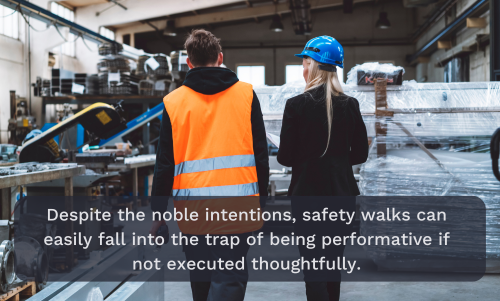Senior Manager Safety Walk: Meaningful Action or Empty Gesture?

Senior leaders play a pivotal role in fostering safety culture. One common practice to emphasize safety as a value is the “safety walk,” where senior managers walk the facility to observe operations, ensure compliance, and interact with employees about safety concerns. The effectiveness of these walks are debatable: are they truly impactful actions, or do they risk being perceived as mere gestures with no lasting influence? Keep in mind that a safety walk is not a safety audit – it is about engaging and building rapport with the workers. It is also about taking action on the information collected.
Dangers of Surface-Level Engagement
Despite the noble intentions, safety walks can easily fall into the trap of being performative if not executed thoughtfully. Employees may see these walks as:
- Inconsistent: If they occur sporadically, they can feel more like a “tick-the-box” exercise than a genuine commitment.
- Superficial: Observing without taking action on identified issues can lead to employee cynicism and erode trust.
- Symbolic Status Parades: Showcasing management without addressing meaningful change.
With a little planning, companies can go deeper than surface-level and make an impact.
5 Ways to Create Meaningful Safety Walks
To transform a safety walk from an empty gesture into a meaningful action, senior managers should consider the following:
- Prepare with Purpose
- Review recent safety reports, incident logs, and employee feedback to identify areas of concern.
- Collaborate with safety professionals to focus on specific issues or trends.
- Comply with site rules and wear required PPE – what you do matters more than what you ay.
- Engage Employees Authentically
- Ask open-ended questions like, “Is the pace of work creating risks by encouraging shortcuts or complacency? How can we address this balance?” or “What improvements could help you feel safer?”
- Listen actively and acknowledge their insights, ensuring follow-up action is taken. Never walk away from unsafe conditions without action.
- Demonstrate Accountability
- Address identified hazards promptly and transparently. Employees should see tangible outcomes from their feedback.
- Hold yourself accountable for creating and sustaining a safe environment – walk the talk.
- Make It Routine
- Consistent, scheduled walks show that safety is an ongoing priority rather than a one-time concern.
- Familiarity builds trust; employees will feel more comfortable raising concerns with visible leaders.
- Integrate Safety Into Broader Leadership Practices
- Safety shouldn’t be siloed into specific events. Embed it into every conversation, decision, and action.
Consider making an assessment tool for safety walks – a checklist managers can review before and after the walk to help them stay on point.
The Verdict: Safety Walks Done Right Can Promote Safety a Value
When executed thoughtfully, safety walks are far more than symbolic. They reinforce a shared commitment to safety, bridge gaps between leadership and the workforce, and uncover opportunities for improvement. Leaders who embrace this opportunity can leave a legacy of trust and a workplace culture where safety is everyone’s responsibility.
The success of a safety walk depends not on its visibility but on its outcomes. A senior manager’s presence alone isn’t enough; it’s the actions taken before, during, and after the walk that determines whether it’s a meaningful endeavor or an empty gesture. By prioritizing authenticity and follow-through, leaders can ensure their safety walks drive real, lasting change.
Safety shouldn’t be a priority … it should be a value. Well-planned safety walks are just one idea companies can implement to help workers adopt safety as a value.

The Global TapRooT® Summit is filled with cutting-edge ideas to drive performance improvement, but implementing those ideas effectively in the workplace can be challenging. During my keynote session, “Making Improvement Happen!”, I’ll share practical strategies like these to help you create impactful, sustainable solutions for making safety a value. Mark your calendar and join us for this transformative event. Discover more about the 2025 Global TapRooT® Summit.



